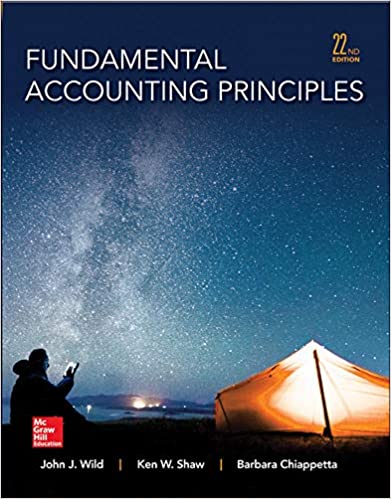
Fundamental Accounting Principles 22th Edition by John Wild ,Ken Shaw,Barbara Chiappetta
Edition 22ISBN: 978-0077862275
Fundamental Accounting Principles 22th Edition by John Wild ,Ken Shaw,Barbara Chiappetta
Edition 22ISBN: 978-0077862275 Exercise 46
Refer to the information in Problem 6-1A and assume the periodic inventory system is used.
Required
1. Compute cost of goods available for sale and the number of units available for sale.
2. Compute the number of units in ending inventory.
3. Compute the cost assigned to ending inventory using ( a ) FIFO, ( b ) LIFO, ( c ) weighted average, and ( d ) specific identification. (Round all amounts to cents.)
4. Compute gross profit earned by the company for each of the four costing methods in part 3.
Reference: Problem 6-1A
Warnerwoods Company uses a perpetual inventory system. It entered into the following purchases and sales transactions for March. (For specific identification, the March 9 sale consisted of 80 units from beginning inventory and 340 units from the March 5 purchase; the March 29 sale consisted of 40 units from the March 18 purchase and 120 units from the March 25 purchase.)

Required
1. Compute cost of goods available for sale and the number of units available for sale.
2. Compute the number of units in ending inventory.
3. Compute the cost assigned to ending inventory using ( a ) FIFO, ( b ) LIFO, ( c ) weighted average, and ( d ) specific identification. (Round all amounts to cents.)
4. Compute gross profit earned by the company for each of the four costing methods in part 3.
Required
1. Compute cost of goods available for sale and the number of units available for sale.
2. Compute the number of units in ending inventory.
3. Compute the cost assigned to ending inventory using ( a ) FIFO, ( b ) LIFO, ( c ) weighted average, and ( d ) specific identification. (Round all amounts to cents.)
4. Compute gross profit earned by the company for each of the four costing methods in part 3.
Reference: Problem 6-1A
Warnerwoods Company uses a perpetual inventory system. It entered into the following purchases and sales transactions for March. (For specific identification, the March 9 sale consisted of 80 units from beginning inventory and 340 units from the March 5 purchase; the March 29 sale consisted of 40 units from the March 18 purchase and 120 units from the March 25 purchase.)

Required
1. Compute cost of goods available for sale and the number of units available for sale.
2. Compute the number of units in ending inventory.
3. Compute the cost assigned to ending inventory using ( a ) FIFO, ( b ) LIFO, ( c ) weighted average, and ( d ) specific identification. (Round all amounts to cents.)
4. Compute gross profit earned by the company for each of the four costing methods in part 3.
Explanation
Inventory
Inventory refers to the work ...
Fundamental Accounting Principles 22th Edition by John Wild ,Ken Shaw,Barbara Chiappetta
Why don’t you like this exercise?
Other Minimum 8 character and maximum 255 character
Character 255


